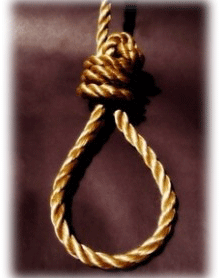Suicides – Can Legalization of Them Promote Murders?
 The World Health Organization predicts that ‘Every year, almost one million people die from suicide; a “global” mortality rate of 16 per 100,000, or one death every 40 seconds.’
The World Health Organization predicts that ‘Every year, almost one million people die from suicide; a “global” mortality rate of 16 per 100,000, or one death every 40 seconds.’
The 2006 report of the National Crime Records Bureau says that India has a suicide rate of 10.5 per 100,000 of population. In which maximum females belonged to age group (15-29 years), and males belonged to the age group of (30-44). As per occupations, the stats are as follows:
Self Employed (41%)
Students (5%)
Unemployed (7.5%)
Housewife (21.2%)
Service (11.5%)
Retired (0.9%)
Others (12.8%)
These statistics indicate many things. The maximum number of females who committed suicide belonged to the age group of (15-29) years which is a real cause of worry. The group definitely include adolescent girls (reasons may be parental or peer pressure, exams, love or harassment) and young woman (may include rape victims, newly married wives, house wives, working women, victims of domestic violence and dowry etc). Another statistics related to occupations suggests that house wives commit most number of suicides after Self Employed people.
It can be easily inferred that most female deaths (which may occur due to domestic violence) are either colored to be suicides or they are actual suicides which occur due to the harassment faced by them. The 91st Report on Dowry Deaths and Law Reform by the Law Commission of India rightly points out that “dowry deaths always take place in closed doors”. If right to suicide is granted then it might happen that many murders would be cloaked as suicides. It would definitely benefit dowry seekers, harassers and assailants but would definitely harm the interests of the victims. Presently abetment to commit suicide is also punishable under Section 306 of I.P.C. If Section 309 which declares attempt to suicide as a crime is abrogated, then this Section may also be amended. If Section 306 is amended or repealed in various cases of domestic violence the accused would be acquitted easily.
Its not just female suicides we are concerned with India faces a huge of farmer suicide as well. In Vidarbha 1,065 farmer committed suicides in 2006 whereas in Chhattisgarh the number was 1,483. The State Governments have always presented low figures of farmer suicides in their territory. They have often shredded their responsibility and have seldom blamed the Center or even the farmers for their miserable condition. If suicide is legalized then it is pretty evident that the government might just comment “It’s their right and they exercised it. What can we do?”
Another thing worth mentioning is the suicide rate amongst the retired which is the lowest. One of the possible reasons might be that they are contended and satisfied with their lives. Various studies have predicted that the most number of suicides occur when a person is depressed or mentally unbalanced. Such decisions cannot be said to be taken with all due care.
Euthanasia is observed by different nations in different approaches. Netherlands, Finland, Sweden, Belgium recognize mercy killing as a right but countries like India and Pakistan. Euthanasia is of two types: active (in which some other person takes steps to hasten the death of other like Cancer or A.I.D’s patients.) and passive (when the person’s life is supported by artificial means).
Mercy killing is a debatable issue. Where some countries believe if we cannot give life we cannot take it either, the others believe that a person has the right to die in such circumstances. Suicide and mercy killing might appear similar but they aren’t. Where mercy killing is usually granted on medical grounds, reasons of suicide are numerous.
In India Article 21 enumerates Right to Life some jurists believe that it also includes Right to Die. Section 309 of the I.P.C makes attempt to suicide a punishable offense with imprisonment up to 1 year or fine or both. In P. Rathinam case the Supreme Court declared 309 as unconstitutional as it violated Article 14 and 21. But the decision was subsequently overruled in Gyan Kaur case. The court observed that “When a man commits suicide he has to undertake certain positive overt acts and the genesis of those acts cannot be traced to, or be included within the protection of the ‘right to life’ under Article 21. The significant aspect of ‘sanctity of life’ is also not to be overlooked. Article 21 is a provision guaranteeing protection of life and personal liberty and by no stretch of imagination can ‘extinction of life’ be read to be included in ‘protection of life’.”
For various reasons mentioned above I would not recommend the legalization of suicide. But Section 309 imposes double punishment on a victim. He is already unsatisfied with his life and wants to end it. Imprisonment or fine would definitely enhance his miseries. Instead of imposing deterrent punishments on him medical assistance, counselling and help must be granted.
Read more